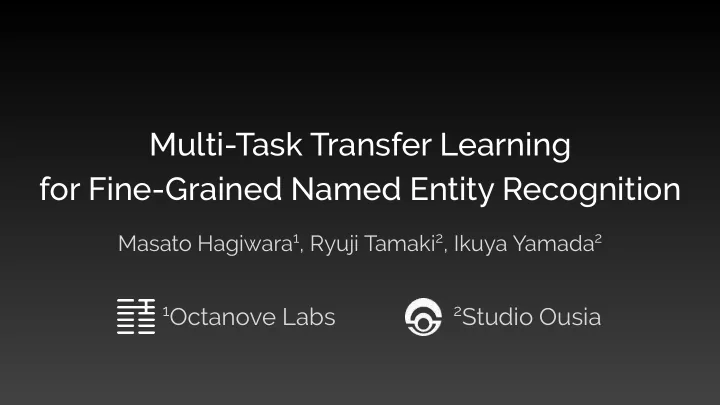

Multi-Task Transfer Learning for Fine-Grained Named Entity Recognition Masato Hagiwara 1 , Ryuji Tamaki 2 , Ikuya Yamada 2 1 Octanove Labs 2 Studio Ousia
Named Entity Recognition (NER) Few systems deal with more than 100+ types ● cf. FIGER 112 types (Ling and Weld, 2012) ○ ● Entity typing ○ (Ren et al., 2016), (Shimaoka et al., 2016), (Yogatama et al., 2015) Can we solve NER (detection and classification) with 7,000+ types in a generic fashion?
Challenge 1: Lack of Training Data Silver-standard dataset Lack of NER datasets with YAGO annotations annotated with AIDA Transfer learning to AIDA
Challenge 2: Large Tag Set Cost of CRF = O(n 2 ) (n = # of types)
Challenge 3: Ambiguity in Types House103544360 vs Hierarchical Multi-label Classification House107971449 WorldOrganization108294696 PhysicalEntity YagoGeoEntity vs Object Location Whole Region Alliance108293982 Artifact District Structure AdministrativeDistrict Memorial Municipality NationalMonument City Plaza108619795 vs The Statue of Liberty in New York Plaza103965456
Challenge 4: Hierarchical Types loc org per professional Hierarchy-aware soft loss politician position governor mayor journalist
Hierarchy-Aware Soft Loss PRED n n a a i r i r GOLD o o c c i n i n r r t r t r o o i e i e r y r y g v g v c l c l a a e e r r o o o o o m o m p p o o p g p g l l loc org x W GOLD per politician Soft GOLD Labels governor mayor Cross entropy loss Type confusion weight W
Experiments Datasets Settings 1) Pre-training ● Embeddings OntoNotes 5.0 (subset) for detection bert-base-cased Silver-standard Wikipedia for classification 2-layer BiLSTM (200 hidden units) Manually-annotated subset for dev. ● Type conversion 2) Fine-tuning 2-layer feed-forward with ReLU Manually-annotated WIkipedia Manually-fixed AIDA sample data Optimization ● (LDC2019E04) Adam (lr = 0.001) for pre-training Manually-annotated OntoNotes 5.0 BertAdam (lr = 1e-5 with 2,500 warm-up) (subset)
Results Performance on validation set Performance on test set Method Prec Rec F1 Run Prec Rec F1 Direct 0.45 0.42 0.43 1st 0.504 0.468 0.485 submission Fine-tuned 0.65 0.57 0.61 After 0.506 0.493 0.499 Fine-tuned 0.60 0.50 0.55 feedback w/o loss
Error Analysis Location vs GPE ● “Southern Maryland” ○ OK: loc.position.region , NG: gpe.provincestate.provincestate ● Ethnic/national groups “Syrians” ○ OK: no annotation, NG: gpe.country.country ● Type too specific ○ “Obama” OK: per.politician , NG: per.politician.headofgovernment Type too generic ● ○ “SANA news agency” OK: org.commercialorganization.newsagency , NG: org
Conclusion Multi-task transfer learning approach for ultra fine-grained NER ● Transfer learning from YAGO to AIDA ○ ○ Multi-task learning of named entity detection and classification ○ Multi-label classification of named entity types Hierarchy-aware soft loss ○
Improvement Ideas Using “type name” embeddings ● e.g., per.professionalposition.spokesperson ○ ○ e.g., org.commercialorganization.newsagency Gazetteers and handcrafted features ● ● Hierarchical model ○ BIO+loc/org/per/... -> more fine-grained types Ensemble ● ● Post-processing ● Finally... read the annotation guideline and examine the training data!
Thanks for listening! Masato Hagiwara 1 , Ryuji Tamaki 2 , Ikuya Yamada 2 1 Octanove Labs 2 Studio Ousia http:/ /www.octanove.com/ http:/ /www.ousia.jp/en/
Recommend
More recommend